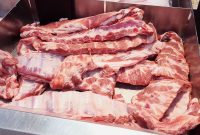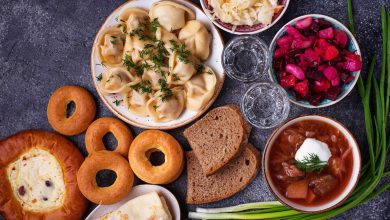Not only raw materials. How the export of Russian food products is growing
The course for the development of the export of value-added products was set by President Vladimir Putin several years ago. Since then, there has not been a global restructuring of the supply structure, but some sectors of the ago-industrial complex have indeed stepped up the export of such goods. The meat, dairy, oil and fat, confectionery and beverage industries can count on further successful conquest of the world market.
Agriculture is systematically moving away from exclusively grain exports, the share of deliveries of products with high added value is growing, Russian Minister of Agriculture Dmitry Patrushev said in the spring. In 2020, we managed to achieve a significant increase in this category. Thus, according to Agroexport, the export of food and processing industry products increased by more than 15% compared to 2019, to $4.5 billion. The geography of supplies is also expanding: for example, Russian ice cream has already appeared in 35 countries, and Russian honey – at 29.
Nomenclature features
The volume of Russian exports for 2012-2020 grew on average in nominal terms by 5% per year, informs the head of the Center for Economic Forecasting of Gazprom bank Daria Sitka. The highest growth rates were in the groups “meat”, “live cattle”, “oilseeds”.
and the lowest in the categories “dairy products”, “eggs” and “alcohol”. In the structure of exports, agricultural raw materials (groups 1-15 of the FEACN) last year accounted for 77% of the total value of exports, and in 2012 it was 75%. “Of course, meat (code 02), vegetable oil (code 15) or flour (included in code 11) can also be considered high value-added products, although according to the nomenclature it is still raw materials,” the expert explains.
Despite the difficulties of international trade in 2020, in general, almost all value-added products show positive dynamics over the past five years, says Inna Gelfand, partner at NEO Center. If we single out individual products, it is worth noting the growth in the supply of frozen pork (TN VED code 0203) and cattle meat (TN VED code 0202). However, among the leaders in terms of increasing shipments are still raw materials.

wheat and corn.
And yet, the most promising positions for export now are food products (ice cream, oils, confectionery, products of deep processing of grain), the expert believes. Due to high quality and low logistics costs, Russian goods will be able to win competition for the European market from Asian companies, she is sure. The export of ice cream and confectionery products is mainly directed to the CIS countries, which lack their own production capacities. With a decrease in domestic prices for poultry meat, the volume of exports of this type of product may also increase.
“I am quite skeptical about the prospects for an active increase in the supply of finished products of the food industry abroad, this is not typical for world trade,” Daria Sitka emphasizes. Of the 100% meat-related products globally exported, according to Comrade, prepared meat products account for only 24%. The structure of trade in cereals and products from them looks more interesting – the share of finished products (mainly confectionery products) here is about 42%.
However, raw materials still form the basis of exports (see graph on page XX). According to the expert, this is primarily due to logistics: transporting finished processed products is usually required in special conditions (refrigerators, for example), often these are small packages, and transporting air is unprofitable. Also, many countries are trying to stimulate the localization of the final stages of processing.
in which value added is formed. This is especially critical for developing countries, namely, they are the recipients of food exports at the global level, argues Sitka. Of course, it is necessary to support finished products as part of the procedures for promoting Russian products abroad, but it is more important and more efficient not to limit the process of expanding the geography of exports of raw materials, she is sure. For example, for wheat, where there is still huge growth potential in the large markets of Algeria, Indonesia.

For most goods, the profitability of export sales is higher than sales on the domestic market due to higher prices, notes Inna Gelfand. For example, the export value of ketchups and sauces is about 27% higher than the local one, vodka — by 38%, frozen fish — by 45%, and fodder meal — by 10%. If we compare the marginality of external sales of value-added products and raw materials.
then the former does not always win, adds Sitka. The key question here is where this value comes from. “I see several options: very cheap feedstock compared to the importing country, the export of which is limited or prohibited – for example, vegetable oil in the case of export duties on oilseeds – or innovative technology – a rare example in the food business, soy protein concentrates,” she says . “Another option is a unique brand – the same Russian chocolate Alena, but in this case, careful protection of trademarks from copying is required, and in some cases, production under the brand still moves to the importing country.”
Oils, fats and sauces
The most massive exported agricultural product with high added value is vegetable oil. And its export from Russia will increase every year, Mikhail Maltese, executive director of the Oil and Fat Union, is sure. In addition, domestic companies are actively exporting soybean and rapeseed products abroad. In 2021, the volume of all oil and fat products sold abroad may reach $6 billion, and by 2030, the industry intends to reach the updated figure of the federal project “Export of Agricultural Products” at $8.6 billion.
Since the industry is export-oriented, prices within the country are formed depending on the global situation. Therefore, from an economic point of view, it does not matter for the processor which market its products will go to, its marginality will not change from this, the expert says. “Realizing that the producers of oil and fat products have provided the volumes of domestic consumption, they are actively developing exports,” he says.



